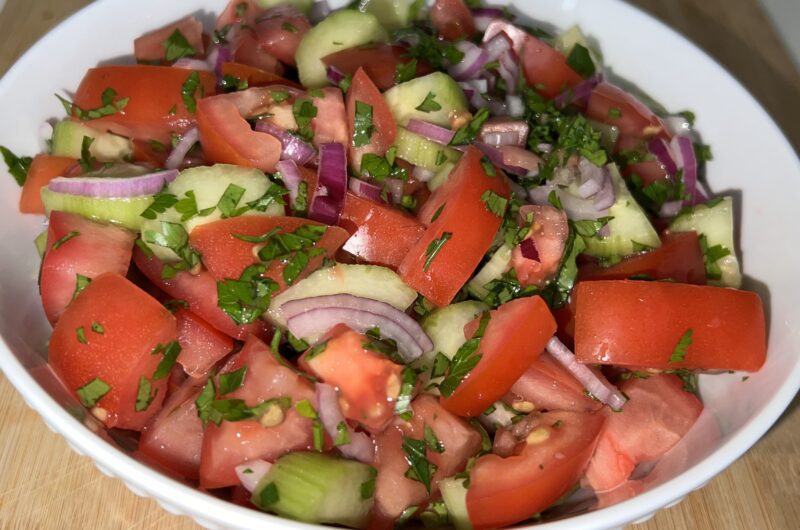This post may contain affiliate links, which means I may receive a commission from purchases made through the links.
Kachumbari is a refreshing salad that’s a staple in East African cuisine. It is a salsa-like blend of fresh ingredients that can liven up any meal. Kachumbari is very closely similar to Pico de Gallo which is popular in Hispanic cuisine and depending on the ingredients you choose, it could also get closer to Guacamole. It is typically served as a side dish or condiment and is known for its crisp, tangy, and sometimes slightly spicy profile. This dish is extremely easy to make and whether you’re a kitchen newbie or a pro, you can whip up delicious kachumbari. In this post, I share all the details on how to make and eat kachumbari – the key ingredients, optional ingredients, the steps for making kachumbari, and ideas on what to serve it with.
The Basics: What You’ll Need
Kachumbari can be as simple as just tomatoes and onions on one end, and as packed as seven or more ingredients on the other. It all depends on what you have at your disposal and how you’re feeling on that particular day – you can keep it simple or go all the way out.
Key Ingredients for Kachumbari
Tomatoes: This is a must-have ingredient. Go for ripe tomatoes that are juicy but firm so that they keep their shape when chopped.
Onions: The red onion is the most preferred type for this dish. It brings a nice sharp bite that balances the sweetness of the tomatoes. I usually add much less onion than an average Kenyan does because that sharpness gets me. However, you can use as much onion as you like.
Coriander (Cilantro): You will need just a small amount of fresh coriander leaves. This herb adds freshness, texture, and a beautiful aroma that’s essential to Kachumbari. Note that you can omit coriander if you wish to, or replace it with fresh parsley, and your kachumbari will still be marvelous.
Lemon Juice: Squeeze in some fresh lemon juice for a zesty twist that will tie everything together and give your Kachumbari that extra zing. Again, you can choose to drop this ingredient too or replace it with slices of lime.
Salt: Add salt to taste. Seasoning is key to bringing out all those delicious flavors. One point to note about salt; only add it when it is time to serve the salad. If you are making it well ahead of time, do not add salt as the raw vegetables will release a lot of their juices and make a bit of a mess.
Optional Ingredients for Kachumbari
Fresh Chili: If you love spicy food, feel free to add some finely chopped chili (green or red, either is fine) to your kachumbari. It blends in perfectly. Adjust the heat based on your spice tolerance.
Avocado: For a creamy twist, chop up a ripe avocado. It adds a rich texture and balances the tangy flavors. This is where kachumbari can begin to look like guacamole, and that is perfectly okay!
Cucumber: Adds a refreshing crunch that further enriches your kachumbari.
Garlic: A minced garlic clove can add a lovely depth of flavor. Perfect if you’re a garlic lover!
How to Put It All Together
- Chop, Chop, Chop: Start by chopping your tomatoes and onions into small, bite-sized pieces. If you’re adding cucumber and avocado, chop those up too. Maintain a uniform size of the main vegetables like tomatoes, onions, and cucumber. For instance, decide between cube-like pieces and long and thin pieces, and cut all the vegetables in that manner for a uniform and beautiful-looking salad. Mince your garlic and dice the coriander and chili if you’re using them.
- Mix and Mingle: Toss all your chopped ingredients into a large bowl. If you’re including garlic and any fresh herbs, mix those in as well.
- Season it Up: Drizzle the lemon juice over your mix. Sprinkle with salt and give everything a good, gentle stir. Taste it—this is where you can tweak the seasoning such as by adding more salt or lemon juice.
- Chill Out: If you are not serving it immediately, let your Kachumbari sit in the fridge. This will not only ensure the freshness of the salad, but it will also allow the flavors to meld together and the dish to cool down, making it extra refreshing.
What to Serve with Kachumbari
Kachumbari is a versatile companion to a ton of dishes, from meats to rice dishes and wheat products. Here’s what you can serve Kachumbari with:
Grilled, baked, or fried meats: Nyama Choma is Swahili for ‘grilled meat’, and it is one dish that pairs most perfectly with Kachumbari. These two are as inseparable as burgers and French fries. Perhaps that’s because kachumbari adds a bright contrast to the smoky, charred flavors of nyama choma. Nyama choma is mostly beef or goat meat, but other roasted or grilled meats, like chicken, can also be served with kachumbari as a side. So, next time you are doing that barbecue, whether quietly in your backyard for a family dinner or at a large cookout with friends, do not forget to make Kachumbari to go with it! Everybody will love it and you’ll be so happy you made it.
Add to this list all the fried and baked meats as well because they all receive an immeasurable boost from kachumbari. In Kenya, for instance, fried chicken and fries are always served with kachumbari.
Ugali: This classic Kenyan staple pairs perfectly with Kachumbari, and often, a third dish which in most cases is a protein – like nyama choma.
Chapati: These soft, flaky flatbreads are ideal for scooping up Kachumbari. It’s a delicious way to enjoy every bit of the salad. Again, a protein like grilled or fried meat or fish would accompany this combo.
Rice dishes: Serve Kachumbari over pilau or even plain rice and meat for a fresh, zesty topping that elevates your rice dish to the next level. In many places I’ve visited in East Africa, a pilau platter is never complete without kachumbari.
Fish: Grilled or fried fish gets a fresh lift from Kachumbari’s tangy punch. It’s a match made in heaven, I’m telling you.
Tacos or Wraps: Feeling adventurous? Use Kachumbari as a topping for tacos or wraps. It adds a delightful crunch and flavor. As I mentioned earlier, it is not far from Pico de Gallo and guacamole, anyway, so you might as well use it.
How to Preserve Leftover Kachumbari
Kachumbari is a raw salad, so it loses freshness quickly. That said, you can observe a few best practices and preserve leftover kachumbari for the next 24 to 48 hours and still enjoy it quite fresh.
Place leftover kachumbari in an airtight container. This is always a sure way to ensure the freshness of food. Keep it in the fridge and only bring it out when ready to enjoy. Otherwise, do not leave it sitting out on the counter for long as it will begin to immediately lose that freshness.
If you make a huge batch of kachumbari that you are sure you won’t finish in a single serving, add salt only to the amount that you plan to eat and preserve the remaining amount unsalted. This will ensure freshness for longer, and the vegetables will also retain their juices, which means you will not have a soggy mess over time.
Serve your leftover kachumbari as you would normally, alongside any dish of your choice. Feel free to experiment with dishes beyond my suggestions above.
Print the Recipe
How to Make Kachumbari: East Africa’s Tomato and Onion Salad
Course: SidesCuisine: Kenyan, East AfricanDifficulty: Easy4
servings5
minutes62
kcal6
minutesKachumbari recipe
Ingredients
Tomatoes – 2
Red onions – 1/2 a piece
Cucumber – 1/2 a piece
Cilantro – 2 tbsp
Salt – to taste
Lemon juice (optional)
Avocado (optional)
Chili peppers (optional
Garlic (optional)
Directions
- Chop, Chop, Chop: Start by chopping all the ingredients. Maintain a uniform size of the main vegetables like tomatoes, onions, and cucumber.
- Mix and Mingle: Toss all your chopped ingredients into a large bowl.
- Season it Up: Drizzle the lemon juice over your mix (optional). Sprinkle with salt and give everything a good, gentle stir. Taste it and make any necessary adjustments.
- Chill Out: If not serving it immediately, let your Kachumbari sit in the fridge. This will not only ensure the freshness of the salad but will also allow the flavors to meld together and the dish to cool down, making it extra refreshing.
Recipe Video
Conclusion
Making Kachumbari is an easy and straightforward process. It’s a very flexible, customizable, and super versatile dish that will wow whomever you serve it to. Whether you’re gearing up for a big feast or just need a fresh side to brighten your day, this fresh and crunchy salad is your new best friend. Enjoy making it, enjoy eating it, and enjoy the flavor it brings to your table!







